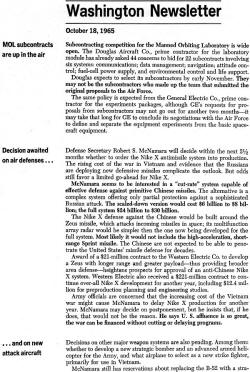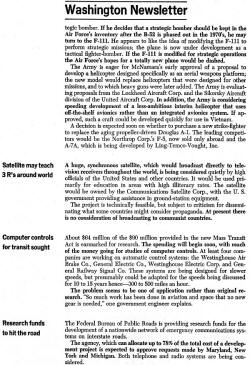|
October 18, 1965 Electronics
 [Table of Contents] [Table of Contents]
Wax nostalgic about and learn from the history of early electronics.
See articles from Electronics,
published 1930 - 1988. All copyrights hereby acknowledged.
|
1965 was the beginning of
America's involvement in Vietnam.
A mere decade had passed since the end of the
Korean War (or "conflict"
if you prefer), and the Department of Defense had not done much to modernize the
military since then. Unlike with World War II when U.S. factories were turning
out military aircraft, ships, and ground vehicles ahead of formal involvement, Congress
was not interested in making headlines with news of war machines. When the first
U.S. troops were sent in March of that year, things kicked into high gear. Lyndon
Johnson was said to have tried to direct the war from the White House, but it was
his Secretary of Defense,
Robert McNamara, whose
actions caused the Vietnam efforts to be nicknamed "McNamara's
War." The "Washington Newsletter" feature of this October 1965 issue of
Electronics magazine reported on, among other military-related items, the U.S.
Air Force's plans to phase out the venerated (now, not then)
B-52 Stratofortress
bomber by sometime in the 1970s. Well, here it is half a century later and the B-52
is still the primary long range heavy bomber in its inventory. More than 60 of the
original 744 built between 1952 and 1962 are flying today (version H). The
B1 Lancer bomber
(supersonic)was a debacle, and the
B2 Spirit bomber
(stealth) is way too expensive to deploy in large numbers. The other headline of
note was early plans for using satellites to broadcast classroom lectures from universities
to remote locations. The few Masters' level electrical engineering courses I took
while at General Electric in Utica, New York, in the late 1980s were via satellite
from the
National Technological University (NTU), based in Boulder, Colorado.
Washington Newsletter
 ... and on New Attack Aircraft ... and on New Attack Aircraft
Decisions on other major weapon systems are also pending. Among them: whether
to develop a new strategic bomber and an advanced armed helicopter for the Army,
and what airplane to select as a new strike fighter, primarily for use in Vietnam.
 McNamara still has reservations about replacing
the B-52 with a strategic bomber. If he decides that a strategic bomber should be
kept in the Air Force's inventory after the B-52 is phased out in the 1970's, he
may turn to the F-111. He appears to like the idea of modifying the F-111 to perform
strategic missions; the plane is now under development as a tactical fighter-bomber.
If the F-111 is modified for strategic operations the Air Force's hopes for a totally
new plane would be dashed. McNamara still has reservations about replacing
the B-52 with a strategic bomber. If he decides that a strategic bomber should be
kept in the Air Force's inventory after the B-52 is phased out in the 1970's, he
may turn to the F-111. He appears to like the idea of modifying the F-111 to perform
strategic missions; the plane is now under development as a tactical fighter-bomber.
If the F-111 is modified for strategic operations the Air Force's hopes for a totally
new plane would be dashed.
The Army is eager for McNamara's early approval of a proposal to develop a helicopter
designed specifically as an aerial weapons platform; the new model would replace
helicopters that were designed for other missions, and to which heavy guns were
later added. The Army is evaluating proposals from the Lockheed Aircraft Corp. and
the Sikorsky Aircraft division of the United Aircraft Corp. In addition, the Army
is considering speeding development of a less-ambitious interim helicopter that
uses off-the-shelf avionics rather than an integrated avionics system. If approved,
such a craft could be developed quickly for use in Vietnam.
A decision is expected soon on whether to purchase a new strike-fighter to replace
the aging propeller-driven Douglas A-1. The leading competitors would be the Northrop
Corp.' s F-5, now sold only abroad and the A-7A, which is being developed by Ling-Temco-Vought,
Inc.
Posted April 15, 2024
(updated from original post
on 10/29/2017)
|






























